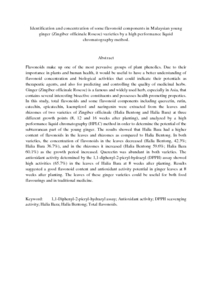Citation
Ghasemzadeh , Ali and Jaafar, Hawa and Rahmat, Asmah
(2010)
Identification and concentration of some flavonoid components in Malaysian young ginger (Zingiber officinale Roscoe) varieties by a high performance liquid chromatography method.
Molecules, 15 (9).
pp. 6231-6243.
ISSN 1431-5157; ESSN: 1420-3049
Abstract
Flavonoids make up one of the most pervasive groups of plant phenolics. Due to their importance in plants and human health, it would be useful to have a better understanding of flavonoid concentration and biological activities that could indicate their potentials as therapeutic agents, and also for predicting and controlling the quality of medicinal herbs. Ginger (Zingiber officinale Roscoe) is a famous and widely used herb, especially in Asia, that contains several interesting bioactive constituents and possesses health promoting properties. In this study, total flavonoids and some flavonoid components including quercetin, rutin, catechin, epicatechin, kaempferol and naringenin were extracted from the leaves and rhizomes of two varieties of Zingiber officinale (Halia Bentong and Halia Bara) at three different growth points (8, 12 and 16 weeks after planting), and analyzed by a high performance liquid chromatography (HPLC) method in order to determine the potential of the subterranean part of the young ginger. The results showed that Halia Bara had a higher content of flavonoids in the leaves and rhizomes as compared to Halia Bentong. In both varieties, the concentration of flavonoids in the leaves decreased (Halia Bentong, 42.3%; Halia Bara 36.7%), and in the rhizomes it increased (Halia Bentong 59.6%; Halia Bara 60.1%) as the growth period increased. Quercetin was abundant in both varieties. The antioxidant activity determined by the 1,1-diphenyl-2-picryl-hydrazyl (DPPH) assay showed high activities (65.7%) in the leaves of Halia Bara at 8 weeks after planting. Results suggested a good flavonoid content and antioxidant activity potential in ginger leaves at 8 weeks after planting. The leaves of these ginger varieties could be useful for both food flavourings and in traditional medicine.
Download File
![[img]](http://psasir.upm.edu.my/15073/1.hassmallThumbnailVersion/Identification%20and%20concentration%20of%20some%20flavonoid%20components%20in%20Malaysian%20young%20ginger.pdf)  Preview |
|
PDF (Abstract)
Identification and concentration of some flavonoid components in Malaysian young ginger.pdf
Download (85kB)
| Preview
|
|
Additional Metadata
Actions (login required)
 |
View Item |

